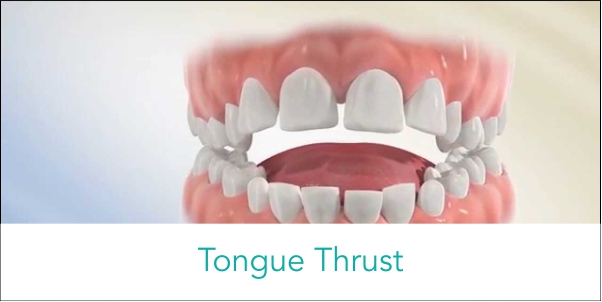What is Tongue Thrust
Tongue thrust (also called reverse swallow or immature swallow) is the common name of orofacial muscular imbalance, a human behavioral pattern in which the tongue protrudes through the anterior incisors during swallowing, speech, and while the tongue is at rest. Nearly all infants exhibit a swallowing pattern involving tongue protrusion, but by six months of age most lose this reflex allowing for the ingestion of solid foods.
Since 1958, the term “tongue thrust” has been described and discussed in speech and dental publications by many writers. Many school-age children have tongue thrust. For example, according to recent literature, as many as 67–95 percent of children 5–8 years old exhibit tongue thrust, which may be associated with or contributing to an orthodontic or speech problem. Up to the age of four, there is a possibility that the child will outgrow tongue thrust. However, if the tongue thrust swallowing pattern is retained beyond that age, it may be strengthened.
Causes of Tongue thrust
Factors that can contribute to tongue thrusting include macroglossia (enlarged tongue), thumb sucking, large tonsils, hereditary factors, ankyloglossia (tongue tie), and certain types of artificial nipples used in feeding infants, alsoallergies or nasal congestion can cause the tongue to lie low in the mouth because of breathing obstruction and finally contributing to tongue thrusting. In addition, it is also seen after prolonged therapy by levodopa in Parkinsonism, also it occurs as extra pyramidal side effect (Acute muscular dystonia) after use of Neuroleptics (Anti-Psychotics).
Effects
Tongue thrust is normal in infants until approximately the age of six months. The loss of this normal infant behavior is one of the signs that the baby is ready to begin eating baby food.
Tongue thrusting can adversely affect the teeth and mouth. A person swallows from 1,200 to 2,000 times every 24 hours with about four pounds (1.8 kg) of pressure each time. If a person suffers from tongue thrusting, this continuous pressure tends to force the teeth out of alignment. Many people who tongue thrust have open bites; the force of the tongue against the teeth is an important factor in contributing to “bad bite” (malocclusion). Many orthodontists have completed dental treatment with what appeared to be good results, only to discover that the case relapsed because of the patient’s tongue thrust. If the tongue is allowed to continue its pushing action against the teeth, it will continue to push the teeth forward and reverse the orthodontic work.
Speech is not frequently affected by the tongue thrust swallowing pattern. The “S” sound (lisping) is the one most affected. The lateral lisp (air forced on the side of the tongue rather than forward) shows dramatic improvement when the tongue thrust is corrected. However, lisping and tongue thrust are not always associated.
Treatment of Tongue thrust
There are two methods for treating tongue thrusting. The patient may place an appliance similar to a nightguard in the mouth at night, or may wear a more permanent device that can be removed and adjusted by a dentist. The other method requires oral habit training, an exercise technique called orofacial myofunctional therapy, that re-educates the muscles associated with swallowing by changing the swallowing pattern. Certified Orofacial Myologists are trained professionals who receive specialty training in this field and are qualified to treat tongue thrust, orofacial myofunctional disorders, and oral habits. Therapy has proven to give the highest percentage of favorable results; however, the appliance is still used and is successful in some cases. However, long term, orofacial myology still offers the highest long term rate of success.
Thanks for reading this content of Dr. Sheibani Nia’s website, best orthodontist in Iran.


